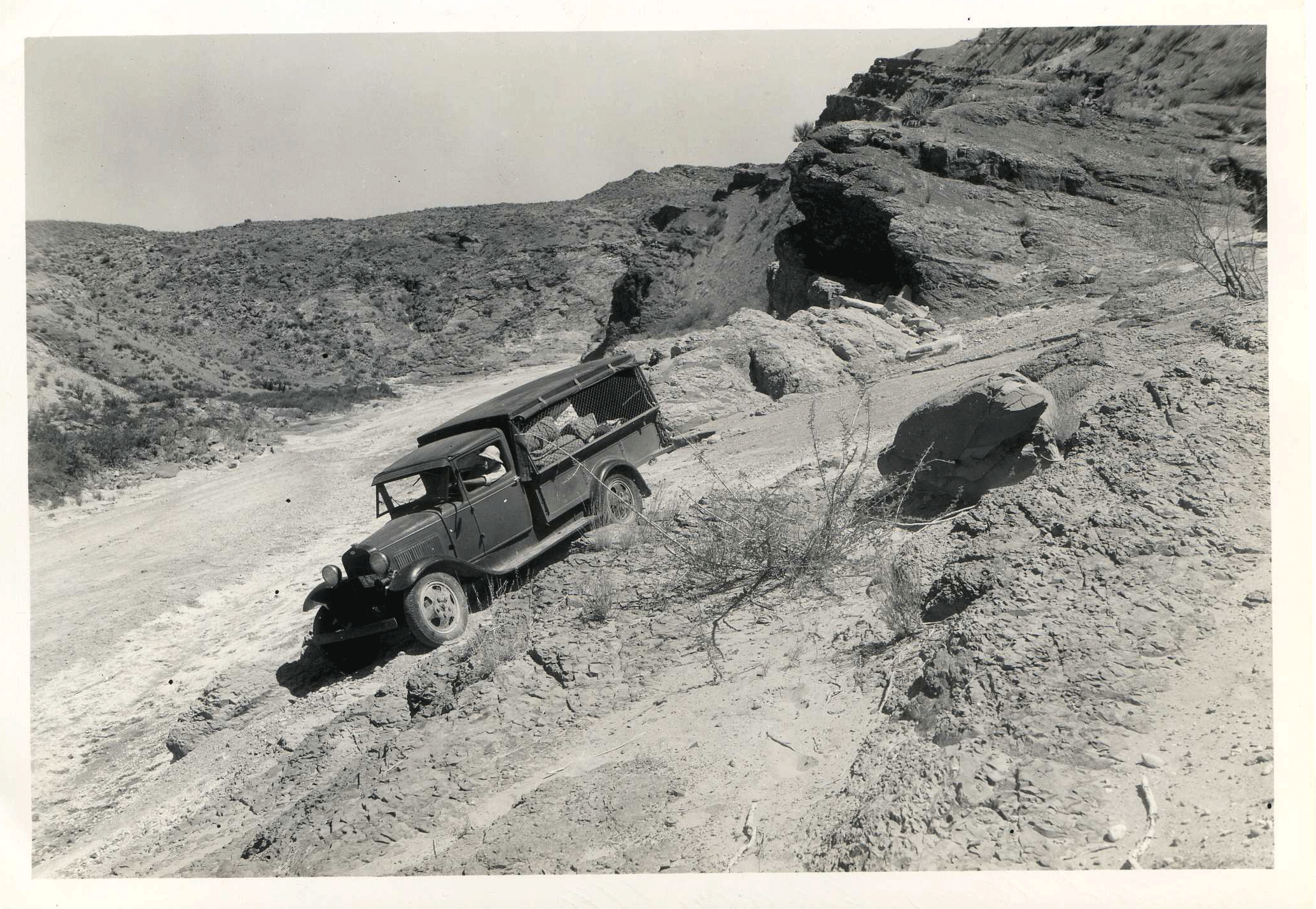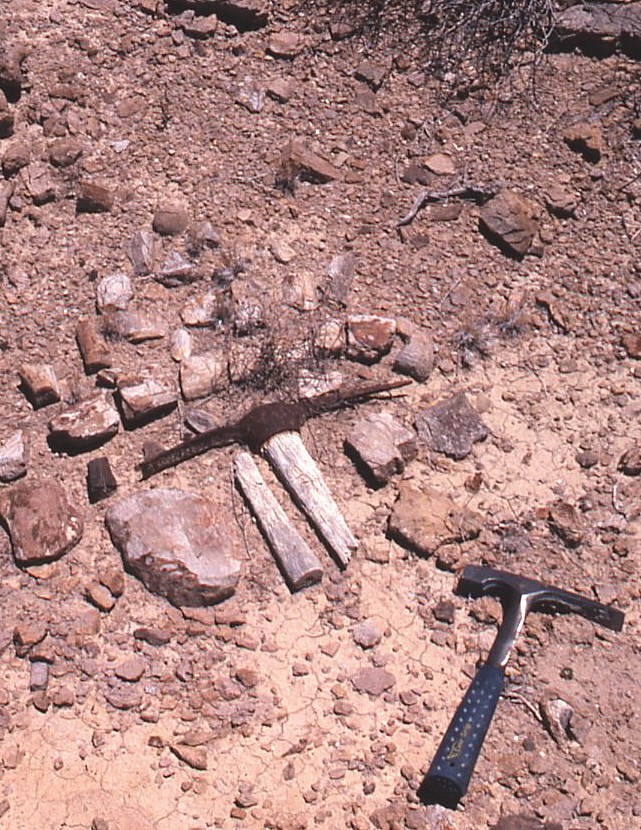Part of a series of articles titled Park Paleontology News - Vol. 16, No. 1, Spring 2024.
Article
Monster Hunters in Big Bend – a Ghost from the Past

Article by Steven L. Wick
University of Texas at Austin
for Park Paleontology Newsletter, Spring 2024

Wikimedia Commons.
Among modern vertebrate paleontologists, it is sometimes said that we often make our discoveries because we “stand on the shoulders of giants”. The phrase doesn’t describe our diminutive stature against that of the many huge and magnificent dinosaurs that we study. Rather, it pays homage to legendary fossil hunters of the past whose research and discoveries have revolutionized our modern scientific understanding of dinosaurs and the world they dominated for around 160 million years prior to their abrupt extinction some 66 million years ago.
Born in 1873, Barnum Brown, curator of fossil reptiles at the American Museum of Natural History in New York, was and continues to be one of those paleontological “giants”. By the early 1900s, Brown had become a celebrity for his stunning discovery of Tyrannosaurus rex (Fig. 1) in the badlands of Wyoming. By the middle of the twentieth century, Brown’s phenomenal success finding dinosaurs and other extinct beasts made him a legend and one of the most renowned scientists in the world. He led an extraordinarily adventurous life and was the “Indiana Jones” of his time—a world traveler and paleontological showman who became as celebrated as the monsters that he hunted.

American Museum of Natural History photo.
In the summer of 1940, Brown and his long-time field assistants R.T. Bird left New York and journeyed into the desert badlands of what is now Big Bend National Park to search for dinosaur bones. They rattled along in their old Ford delivery wagon into areas that would, today, challenge a modern 4x4 (Fig. 2). Here in the sweltering heat, Brown, then in his mid-60s, and Bird, in persistent ill health, explored many rugged areas of today’s national park and collected several scientifically important fossil specimens from Late Cretaceous-aged rocks. Among their most impressive discoveries include skull parts of the hyper-giant primitive alligator Deinosuchus, an intact skull of the armored dinosaur Edmontonia, skull and limb bones of an enormous duck-billed hadrosaur, the partial skeleton of a horned dinosaur similar to the well-known Triceratops, and huge bones of Alamosaurus, a long-necked, quadrupedal titanosaur that, in life, may have weighed as much as 50 tons or more. In fact, Brown had questioned the survival of sauropods into the Late Cretaceous, but the giant bones from Big Bend finally convinced him that long-necked sauropods did indeed survive until the end of the Cretaceous—a discovery that opened today’s park as the best place in North America to study these prehistoric behemoths. Due to the onset of World War II, these fossils would be the last dinosaur bones Brown would ever collect, marking Big Bend as the exclamation point at the end of a phenomenal paleontological career. Brown passed away in 1963, himself becoming “extinct” just as modern paleontology was catching up with all of his many accomplishments.

Works Progress Administration photo.
Oddly, it was on yet another hot day in 1980 that Barnum Brown made another, rather unexpected, appearance in the wilds of Big Bend National Park. Dr. Tom Lehman—then a geology graduate student at The University of Texas at Austin—had also travelled to the park with the eminent paleontologist Dr. Wann Langton Jr. in search of their own extinct monsters. Langston, born in 1921, was in fact a younger colleague of Brown’s who had actually met the venerable bone-hunter on one or two occasions. Of course, Lehman and Langston knew Brown had been in the park in 1940 and, in fact, they had been exploring some of the very same areas visited by Brown and Bird some 40 years earlier. Among these were several large fossil quarries near Talley Mountain excavated in 1938 and ’39 by W.S. Strain and his team from the El Paso College of Mines and Metallurgy (now the University of Texas at El Paso) who, with assistance from the Works Progress Administration (WPA), had been searching for a mountable dinosaur skeleton for the college’s soon-to-open Centennial Museum (Fig. 3).

Photo courtesy T. Lehman.
It was here, at WPA quarry #3, that Lehman stumbled upon something strange… a broken rock pick. Such an artifact in the floor of an old fossil quarry was not that unusual—in fact, it might well be expected. However, what he saw was that the fractured handle of the worn-out pick had been carefully placed alongside the portion still attached to its now-rusted metal head, both pieces carefully encircled in dinosaur bone fragments apparently collected from the grounds nearby. Lehman got the impression that the old pick had been “laid-to-rest”—a shrine of sorts—created by its last owner as a final ode to a trusty comrade; the singular bond between explorer and pick ultimately sundered there just below Talley Mountain at lonely, windswept WPA #3 (Fig. 4). Without disturbing the site, Lehman took a quick photo and trundled off to find Langston and tell him of his peculiar find.
Upon his arrival back at the site and having seen the little shrine, Langston was thunderstruck. To Lehman, it looked as if his mentor had seen a ghost. From the perspective of the younger paleontologist, the solitary monument was odd and interesting, but not particularly significant. But, to the elder Langston, it was a remarkable piece of antiquity. It wasn’t the old WPA quarry they were standing in that got his attention (the WPA quarries have their own unique place in the paleontological history of the park), nor was it the eccentric enshrinement of bones surrounding the broken artifact. It was the old, weathered pick itself that told Langston the real secret. Langston immediately saw that it was not just any type of rock pick… it was, in fact, a “dinosaur pick” of the unique type invented in the 1930s by Barnum Brown himself. While examining the little shrine, Langston could only emphasize to Lehman that: “Nobody on Strain’s ragtag crew would have had such a pick in 1940, nor would they have left something that useful and valuable behind”. Langston concluded that “Only Brown himself could have known about, or even afforded to carry such a specialized tool” (Fig. 5). In fact, Brown’s 1940 visit to Big Bend was, in part, the result of having heard about Strain’s earlier success in Big Bend, and he likely visited the area because it was at that time “virgin territory” for dinosaur fossils in North America and he was not to be left out. Now that Brown was in-the-know about Big Bend’s dinosaurs, undoubtedly a visit to Strain’s abandoned fossil quarry was no accident given that it is less than half a mile as the crow flies from the location where Brown and Bird discovered the huge, partial jaw of fearsome Deinosuchus.

With Lehman at his side, Langston could not help but marvel at the find. Nor could he help but collect the revered, if broken, pick. It is worth noting that, at that time (only 40 years after Brown’s visit), the old pick was really not of archeological significance, but rather amounted to a discarded piece of junk that the venerable Langston and his student Lehman had the foresight to photograph and preserve. In fact, Langston had the pick framed and, for years, it hung on the wall of his office at The University of Texas at Austin. Upon Langston’s passing, by request of the author, the iconic broken dinosaur pick was graciously returned to Big Bend National Park by Langston’s family. It now resides in the park’s collections—a testament to one of the greatest paleontologists that ever lived and his everlasting connection to Big Bend National Park.
Steve Wick has been studying and writing about dinosaurs and paleontology in Big Bend National Park for over 25 years and is a longtime colleague of Dr. Tom Lehman as well as the late Dr. Wann Langston Jr., whom the author had the honor of getting to know over many lunch outings while visiting U.T.’s Vertebrate paleontology Laboratory in Austin, Texas.
Related Links
-
Big Bend National Park (BIBE), Texas—[BIBE Geodiversity Atlas] [BIBE Park Home] [BIBE npshistory.com]
Last updated: April 3, 2024
